Chemical and Leaching Behavior of Construction and Demolition Wastes and Recycled Aggregates
Abstract
1. Introduction
2. Materials and Methods
2.1. Construction and Demolition Wastes (CDWs) and Recycled Aggregates (RAs)
2.2. Chemical Composition and Leaching Behavior Data
2.3. Data Analysis
3. Results and Discussion
3.1. Chemical Composition of CDWs and RAs
3.2. Leaching Behavior of CDWs and RAs
4. Conclusions
- F, Cl, Ni, Cr, and Pb are critical parameters only for CDWs;
- SO4, Cu, and COD are critical parameters for both CDWs and RAs;
- SO4 is released mainly from mixed CDWs (EWC 170904) due to the presence of gypsum, ceramic materials, and mortar particles;
- Cr is released by concrete fractions (EWC 170101) due to the presence of cement;
- COD is released by cement and concrete CDWs (EWC 170101), soil and stones (EWC 170504), and mixed CDWs (EWC 170904).
Author Contributions
Funding
Acknowledgments
Conflicts of Interest
References
- Del Rey, I.; Ayuso, J.; Galvín, A.P.; Jiménez, J.R.; Barbudo, A. Feasibility of using unbound mixed recycled aggregates from CDW over expansive clay subgrade in unpaved rural roads. Materials 2016, 9, 931. [Google Scholar] [CrossRef] [PubMed]
- Jiménez, J.R.; Ayuso, J.; Galvín, A.P.; López, M.; Agrela, F. Use of mixed recycled aggregates with a low embodied energy from non-selected CDW in unpaved rural roads. Constr. Build. Mater. 2012, 34, 34–43. [Google Scholar] [CrossRef]
- Martinez-Echevarria, M.J.; Lopez-Alonso, M.; Garach, L.; Alegre, J.; Poon, C.S.; Agrela, F.; Cabrera, M. Crushing treatment on recycled aggregates to improve their mechanical behaviour for use in unbound road layers. Constr. Build. Mater. 2020, 263, 120517. [Google Scholar] [CrossRef]
- De Brito, J.; Agrela, F. New Trends in Eco-Efficient and Recycled Concrete; Elsevier: Amsterdam, The Netherlands, 2018; ISBN 9780081024805. [Google Scholar]
- López-Uceda, A.; Galvín, A.P.; Ayuso, J.; Jiménez, J.R.; Vanwalleghem, T.; Peña, A. Risk assessment by percolation leaching tests of extensive green roofs with fine fraction of mixed recycled aggregates from construction and demolition waste. Environ. Sci. Pollut. Res. 2018, 25, 36024–36034. [Google Scholar] [CrossRef] [PubMed]
- Eurostat Generation of Waste by Economic Activity. Available online: https://ec.europa.eu/eurostat/databrowser/view/ten00106/default/table?lang=en (accessed on 9 November 2020).
- ISPRA. Rapporto Rifiuti Speciali 2020; Istituto Superiore per la Protezione e la Ricerca Ambientale: Rome, Italy, 2020.
- ISPRA. Rapporto Rifiuti Speciali 2019; Istituto Superiore per la Protezione e la Ricerca Ambientale: Rome, Italy, 2019.
- Giorgi, S.; Lavagna, M.; Campioli, A. Guidelines for Effective and Sustainable Recycling of Construction and Demolition Waste. In Designing Sustainable Technologies, Products and Policies; Springer International Publishing: Cham, Switzerland, 2018; pp. 211–221. [Google Scholar]
- Vegas, I.; Broos, K.; Nielsen, P.; Lambertz, O.; Lisbona, A. Upgrading the quality of mixed recycled aggregates from construction and demolition waste by using near-infrared sorting technology. Constr. Build. Mater. 2015, 75, 121–128. [Google Scholar] [CrossRef]
- Legambiente. Rapporto Cave; Legambiente: Rome, Italy, 2017. [Google Scholar]
- Gálvez-Martos, J.L.; Styles, D.; Schoenberger, H.; Zeschmar-Lahl, B. Construction and demolition waste best management practice in Europe. Resour. Conserv. Recycl. 2018, 136, 166–178. [Google Scholar] [CrossRef]
- Deloitte. Screening Template for Construction and Demolition Waste Management in Italy; Deloitte: London, UK, 2015. [Google Scholar]
- Muñoz, J.; Muñoz, M.A.B.; Romero, J.R.; Galvín, A.P.; Aguilar, M.L.; Casanova, M.; Barrios, A.J.G.; Garrido, M.; López, M.J.; Martínez, R.H.; et al. Guía de Áridos de Residuos de Construcción y Demolición (RCD) de Andalucía Central; Agencia de obra pública de la junta de Andalucía: Sevilla, Spagna, 2015. [Google Scholar]
- Use of Recycled and Manufactured Aggregates in Concrete: An Overview. Available online: https://www.researchgate.net/profile/Jorge_Brito5/publication/283326309_Use_of_Recycled_and_Secondary_Aggregates_in_Concrete_An_Overview/links/56338c6808aeb786b7013688.pdf (accessed on 7 December 2020).
- Butera, S.; Christensen, T.H.; Astrup, T.F. Composition and leaching of construction and demolition waste: Inorganic elements and organic compounds. J. Hazard. Mater. 2014, 276, 302–311. [Google Scholar] [CrossRef]
- Galvín, A.P.; Ayuso, J.; Agrela, F.; Barbudo, A.; Jiménez, J.R. Analysis of leaching procedures for environmental risk assessment of recycled aggregate use in unpaved roads. Constr. Build. Mater. 2013, 40, 1207–1214. [Google Scholar] [CrossRef]
- Del Rey, I.; Ayuso, J.; Galvín, A.P.; Jiménez, J.R.; López, M.; García-Garrido, M.L. Analysis of chromium and sulphate origins in construction recycled materials based on leaching test results. Waste Manag. 2015, 46, 278–286. [Google Scholar] [CrossRef]
- Barbudo, A.; Galvín, A.P.; Agrela, F.; Ayuso, J.; Jiménez, J.R. Correlation analysis between sulphate content and leaching of sulphates in recycled aggregates from construction and demolition wastes. Waste Manag. 2012, 32, 1229–1235. [Google Scholar] [CrossRef]
- Vieira, C.S.; Pereira, P.M. Use of Mixed Construction and Demolition Recycled Materials in Geosynthetic Reinforced Embankments. Indian Geotech. J. 2018, 48, 279–292. [Google Scholar] [CrossRef]
- Martín-Morales, M.; Zamorano, M.; Ruiz-Moyano, A.; Valverde-Espinosa, I. Characterization of recycled aggregates construction and demolition waste for concrete production following the Spanish Structural Concrete Code EHE-08. Constr. Build. Mater. 2011, 25, 742–748. [Google Scholar] [CrossRef]
- Coudray, C.; Amant, V.; Cantegrit, L.; Le Bocq, A.; Thery, F.; Denot, A.; Eisenlohr, L. Influence of Crushing Conditions on Recycled Concrete Aggregates (RCA) Leaching Behaviour. Waste Biomass Valorization 2017, 8, 2867–2880. [Google Scholar] [CrossRef]
- Galvín, A.P.; Ayuso, J.; Barbudo, A.; Cabrera, M.; López-Uceda, A.; Rosales, J. Upscaling the pollutant emission from mixed recycled aggregates under compaction for civil applications. Environ. Sci. Pollut. Res. 2018, 25, 36014–36023. [Google Scholar] [CrossRef] [PubMed]
- Maia, M.B.; De Brito, J.; Martins, I.M.; Silvestre, J.D. Toxicity of Recycled Concrete Aggregates: Review on Leaching Tests. Open Constr. Build. Technol. J. 2018, 12, 187–196. [Google Scholar] [CrossRef]
- Li, X.D.; Poon, C.S.; Sun, H.; Lo, I.M.C.; Kirk, D.W. Heavy metal speciation and leaching behaviors in cement based solidified/stabilized waste materials. J. Hazard. Mater. 2001, 82, 215–230. [Google Scholar] [CrossRef]
- Sorlini, S.; Collivignarelli, M.C.; Abbà, A. Leaching behaviour of municipal solid waste incineration bottom ash: From granular material to monolithic concrete. Waste Manag. Res. 2017, 35, 978–990. [Google Scholar] [CrossRef]
- Bestgen, J.O.; Cetin, B.; Tanyu, B.F. Effects of extraction methods and factors on leaching of metals from recycled concrete aggregates. Environ. Sci. Pollut. Res. 2016, 23, 12983–13002. [Google Scholar] [CrossRef]
- Mahedi, M.; Cetin, B. Carbonation based leaching assessment of recycled concrete aggregates. Chemosphere 2020, 250, 126307. [Google Scholar] [CrossRef]
- Galvín, A.P.; Ayuso, J.; Jiménez, J.R.; Agrela, F. Comparison of batch leaching tests and influence of pH on the release of metals from construction and demolition wastes. Waste Manag. 2012, 32, 88–95. [Google Scholar] [CrossRef]
- Saca, N.; Dimache, A.; Radu, L.R.; Iancu, I. Leaching behavior of some demolition wastes. J. Mater. Cycles Waste Manag. 2017, 19, 623–630. [Google Scholar] [CrossRef]
- López Meza, S.; Kalbe, U.; Berger, W.; Simon, F.G. Effect of contact time on the release of contaminants from granular waste materials during column leaching experiments. Waste Manag. 2010, 30, 565–571. [Google Scholar] [CrossRef] [PubMed]
- Engelsen, C.J.; van der Sloot, H.A.; Wibetoe, G.; Petkovic, G.; Stoltenberg-Hansson, E.; Lund, W. Release of major elements from recycled concrete aggregates and geochemical modelling. Cem. Concr. Res. 2009, 39, 446–459. [Google Scholar] [CrossRef]
- Chen, J.; Tinjum, J.M.; Edil, T.B. Leaching of Alkaline Substances and Heavy Metals from Recycled Concrete Aggregate Used as Unbound Base Course. Transp. Res. Rec. J. Transp. Res. Board 2013, 2349, 81–90. [Google Scholar] [CrossRef]
- Bandow, N.; Gartiser, S.; Ilvonen, O.; Schoknecht, U. Evaluation of the impact of construction products on the environment by leaching of possibly hazardous substances. Environ. Sci. Eur. 2018, 30, 14. [Google Scholar] [CrossRef]
- López-Uceda, A.; Galvín, A.P.; Barbudo, A.; Ayuso, J. Long-term leaching and mechanical behaviour at recycled aggregate with different gypsum contents. Environ. Sci. Pollut. Res. 2019, 26, 35565–35573. [Google Scholar] [CrossRef]
- Agrela, F.; Díaz-López, J.L.; Rosales, J.; Cuenca-Moyano, G.M.; Cano, H.; Cabrera, M. Environmental assessment, mechanical behavior and new leaching impact proposal of mixed recycled aggregates to be used in road construction. J. Clean. Prod. 2021, 280, 124362. [Google Scholar] [CrossRef]
- Barbudo, A.; Agrela, F.; Ayuso, J.; Jiménez, J.R.; Poon, C.S. Statistical analysis of recycled aggregates derived from different sources for sub-base applications. Constr. Build. Mater. 2012, 28, 129–138. [Google Scholar] [CrossRef]
- Sustainable Application of Construction and Demolition Waste: A Review. Available online: https://www.researchgate.net/publication/318601743_SUSTAINABLE_APPLICATION_OF_MATERIALS_FROM_CONSTRUCTION_AND_DEMOLITION_WASTE_A_REVIEW (accessed on 7 December 2020).
- Methods for Presenting Statistical Information: The Box Plot. Available online: https://www.researchgate.net/publication/228337586_Methods_for_presenting_statistical_information_The_box_plot (accessed on 7 December 2020).
- Mulugeta, M.; Engelsen, C.J.; Wibetoe, G.; Lund, W. Charge-based fractionation of oxyanion-forming metals and metalloids leached from recycled concrete aggregates of different degrees of carbonation: A comparison of laboratory and field leaching tests. Waste Manag. 2011, 31, 253–258. [Google Scholar] [CrossRef]
- Abbaspour, A.; Tanyu, B.F.; Cetin, B. Impact of aging on leaching characteristics of recycled concrete aggregate. Environ. Sci. Pollut. Res. 2016, 23, 20835–20852. [Google Scholar] [CrossRef]
- Engelsen, C.J. Leaching performance of recycled aggregates. In Advances in Construction and Demolition Waste Recycling; Elsevier: Amsterdam, The Netherlands, 2020; ISBN 978-0-12-819055-5. [Google Scholar]
- Ben Maaouia, O.; Hamzaoui, R.; Bennabi, A.; Colin, J.; Colina, H. Chromium stabilization and trapping in the cement matrix of recycled concrete aggregates. Constr. Build. Mater. 2018, 191, 667–678. [Google Scholar] [CrossRef]
- Nurhanim, A.A.; Norli, I.; Morad, N.; Khalil, H.P.S.A. Leaching Behavior of Construction and Demolition Waste (Concrete and Gypsum). Iran. J. Energy Environ. 2016, 7, 2079–2115. [Google Scholar] [CrossRef]
- Melendez, B.A. A Study of Leachate Generated from Construction and Demolition Landfills; Calhoun: San Francisco, CA, USA, 1996. [Google Scholar]
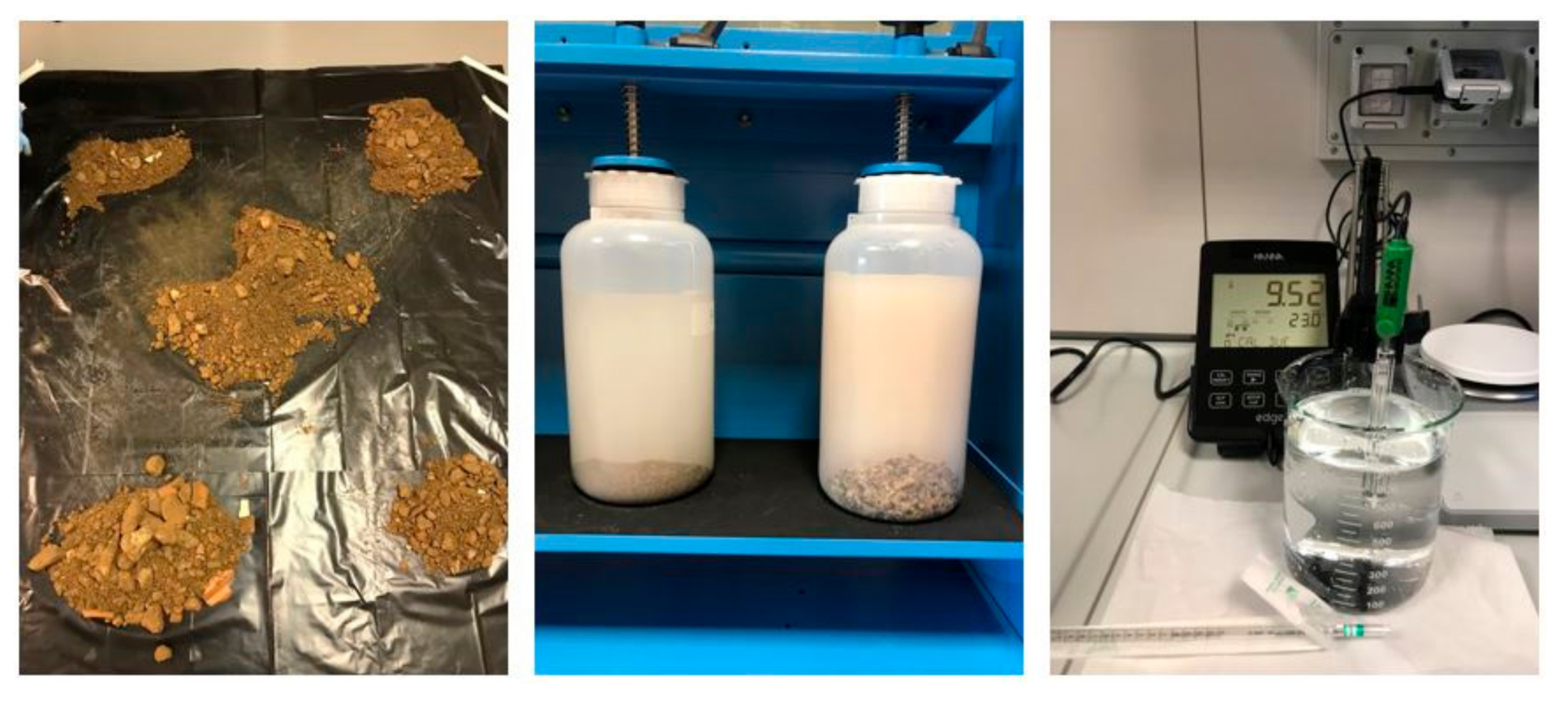
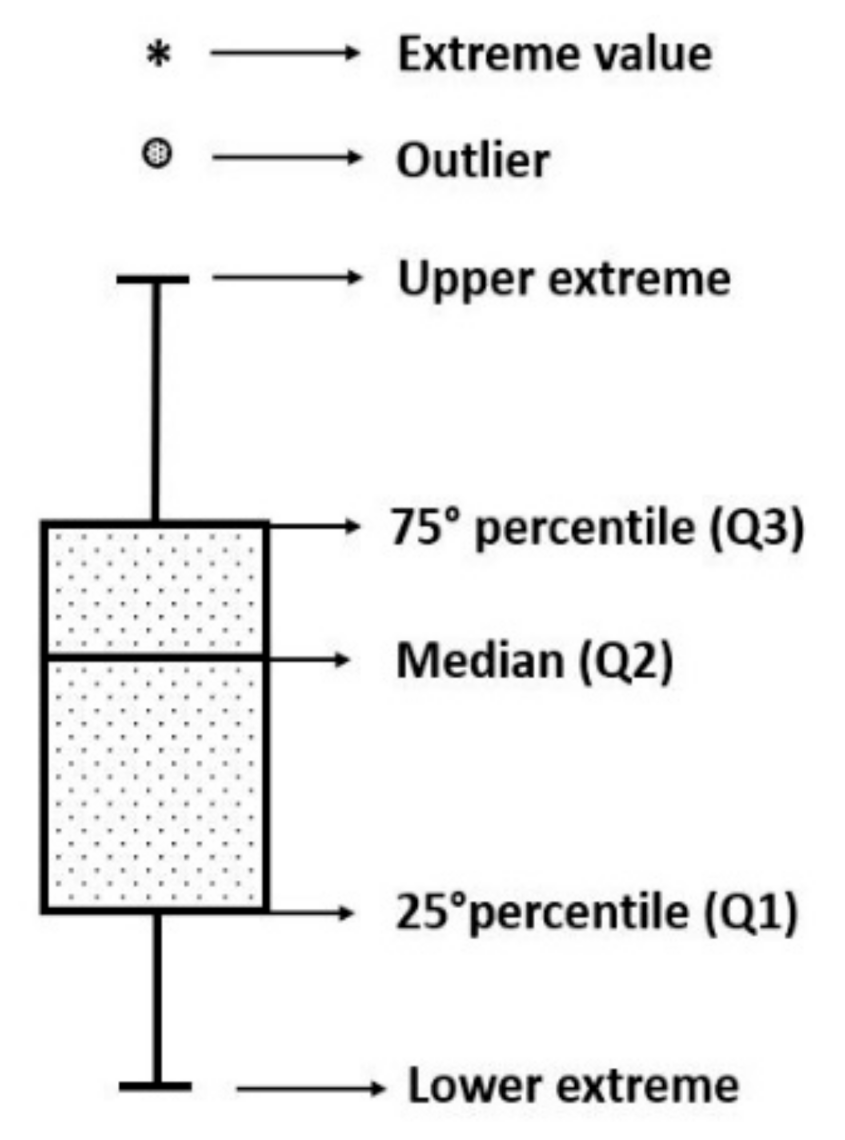
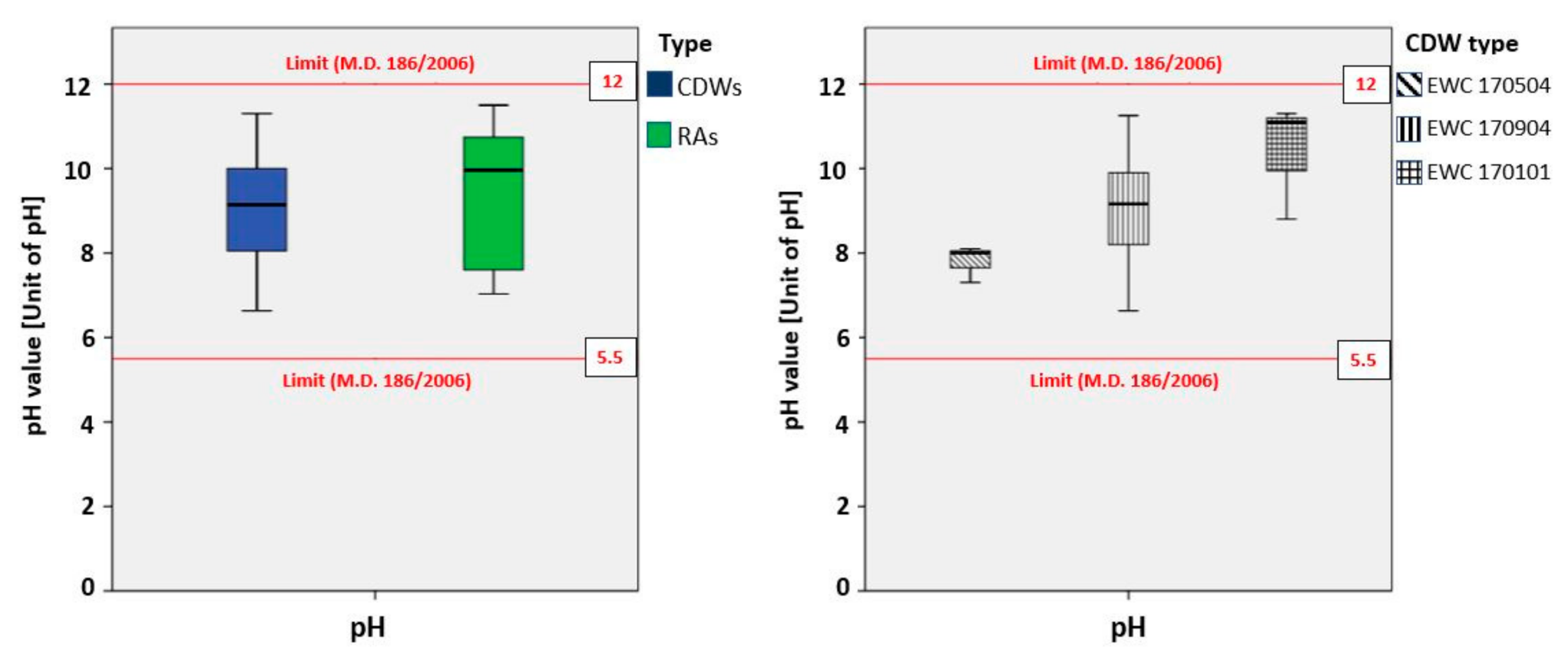
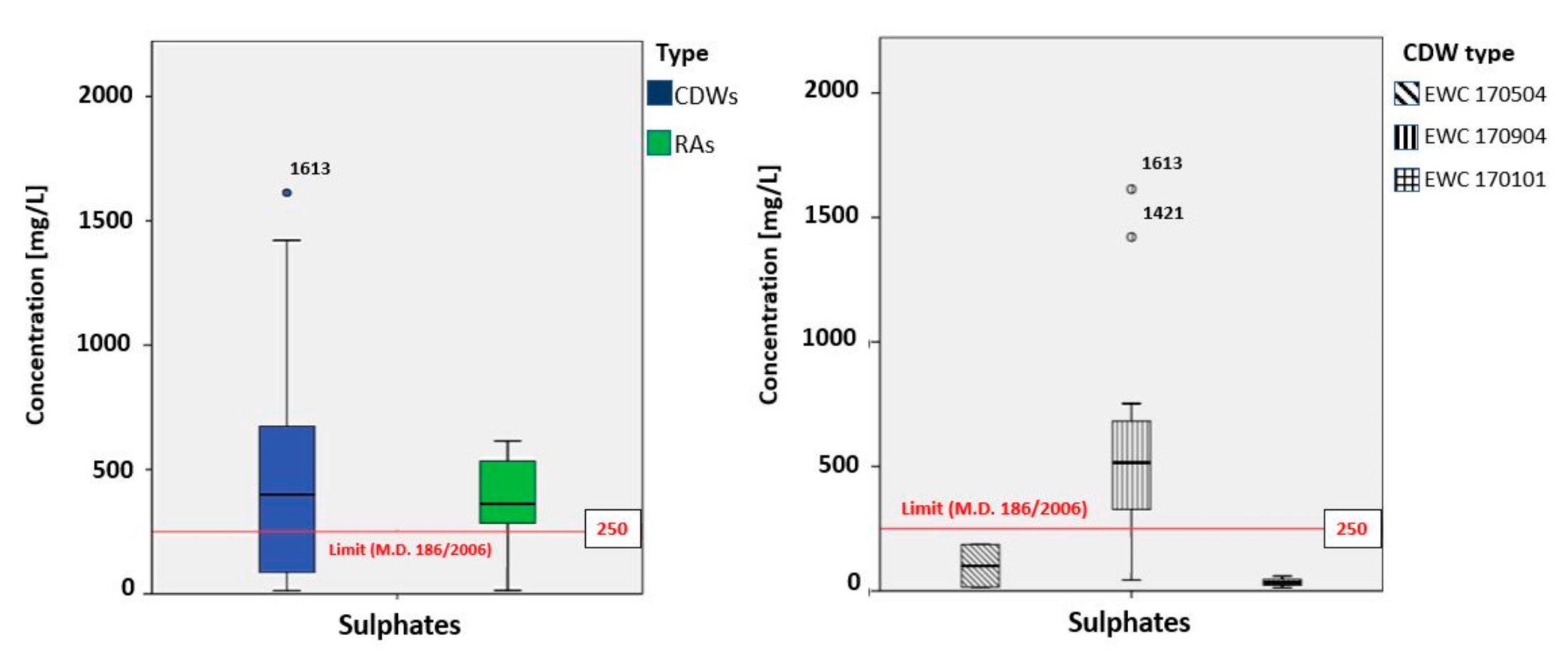
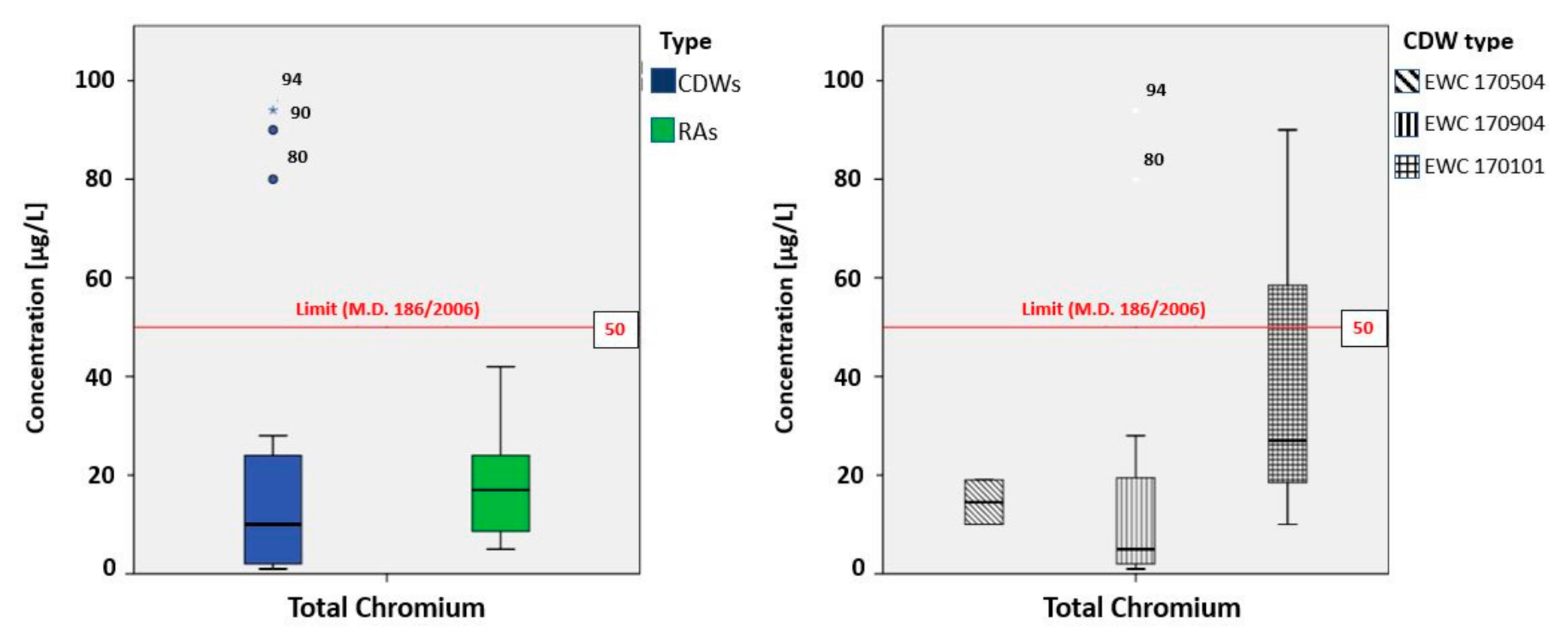
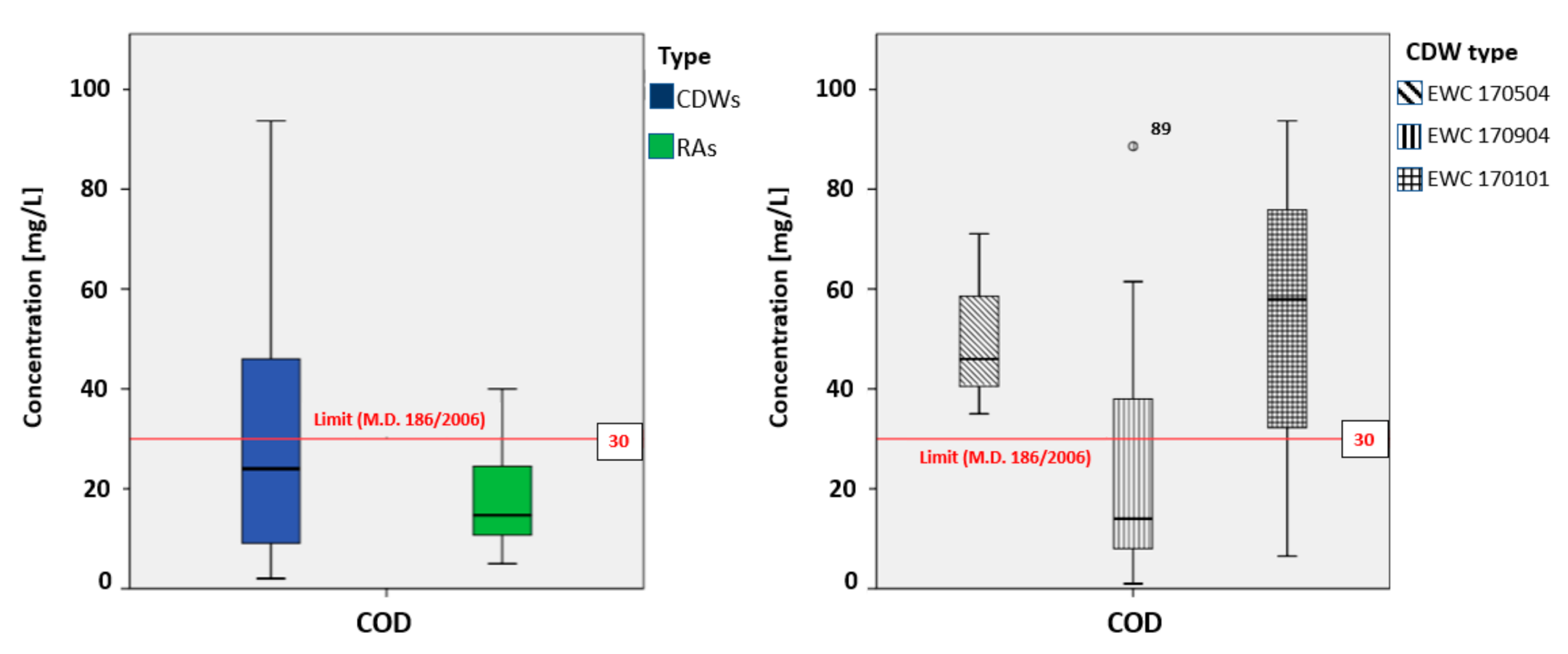
| EWC | Description |
|---|---|
| 170101 | Concrete |
| 170504 | Soil and stones other than those mentioned in 170503 |
| 170904 | Mixed construction and demolition wastes other than those mentioned in 170901, 170902, and 17003 |
| Analysis | Sample | |
|---|---|---|
| CDWs | RAs | |
| Chemical composition | 14 | 1 |
| Leaching test | 27 | 12 |
| Element | U.M. | CDWs | RAs | |
|---|---|---|---|---|
| Min | Max | |||
| Dry residue at 105° | % | 83.9 | 100 | 83.10 |
| pH | - | 6.80 | 11.22 | n.d. |
| Aluminum | [mg/kg] | 502.30 | 12,021 | 9442 |
| Antimony | [mg/kg] | 5 | 10.8 | <10 |
| Arsenic | [mg/kg] | 1 | 27.8 | 11 |
| Beryllium | [mg/kg] | 1 | <14 | <10 |
| Cadmium | [mg/kg] | 1 | <14 | <10 |
| Cobalt | [mg/kg] | 0.10 | 14 | <10 |
| Total chromium | [mg/kg] | 4.80 | 277.7 | 55.40 |
| Chromium (VI) | [mg/kg] | 0.10 | <50 | <10 |
| Iron | [mg/kg] | 211.30 | 211.30 | n.d. |
| Mercury | [mg/kg] | 0.10 | <14 | <10 |
| Nickel | [mg/kg] | 1 | 86.9 | 14.20 |
| Manganese | [mg/kg] | 0.10 | 1070 | n.d. |
| Lead | [mg/kg] | 0.50 | 236 | 33.45 |
| Molybdenum | [mg/kg] | 0.10 | <14 | n.d. |
| Total Copper | [mg/kg] | 1 | 153 | 67.60 |
| Barium | [mg/kg] | 1 | 167 | n.d. |
| Tin | [mg/kg] | 0.10 | <14 | <10 |
| Silicon | [mg/kg] | 240 | 421,000 | n.d. |
| Vanadium | [mg/kg] | 12 | 80 | <10 |
| Selenium | [mg/kg] | 0.10 | 13.3 | n.d. |
| Zinc | [mg/kg] | 5 | 800 | 50.30 |
| Mineral Oils | [mg/kg] | 0.50 | 5800 | 11.60 |
| Benzene | [mg/kg] | 0.10 | <10 | n.d. |
| Asbestos | [mg/kg] | <1000 | <1000 | <1000 |
| Element | U.M. | CDWs | RAs | Limit (M.D.186/2006) | ||
|---|---|---|---|---|---|---|
| Min | Max | Min | Max | |||
| pH | - | 6.60 | 11.30 | 7 | 11.50 | 5.50–12 |
| Nitrates | [mg/L] | 0.05 | 27 | 1.20 | 29.10 | 50 |
| Fluoride | [mg/L] | 0.08 | 2.09 | 0.13 | 0.50 | 1.50 |
| Sulphates | [mg/L] | 12.40 | 1613 | 13.90 | 615 | 250 |
| Chloride | [mg/L] | 0.77 | 186 | 3.10 | 16.60 | 100 |
| Cyanide | [μg/L] | 5 | 20 | 5 | 20 | 50 |
| Barium | [mg/L] | 0.002 | 0.34 | 0.01 | 0.10 | 1 |
| Copper | [mg/L] | 0.001 | 0.067 | 0.002 | 0.08 | 0.05 |
| Zinc | [mg/L] | 0.005 | 0.058 | 0.001 | 0.01 | 3 |
| Beryllium | [μg/L] | 1 | 5 | 0.10 | 5 | 10 |
| Cobalt | [μg/L] | 1 | 10 | 0.40 | 5 | 250 |
| Nickel | [μg/L] | 1 | 14.90 | 1 | 6.20 | 10 |
| Vanadium | [μg/L] | 0.15 | 199 | 0.015 | 34 | 250 |
| Arsenic | [μg/L] | 1 | 11 | 1 | 5 | 50 |
| Cadmium | [μg/L] | 0.20 | 4.80 | 0.10 | 1 | 5 |
| Total Chromium | [μg/L] | 1 | 94 | 5 | 42 | 50 |
| Lead | [μg/L] | 1 | 78 | 0.10 | 5 | 50 |
| Selenium | [μg/L] | 1 | 5 | 0.60 | 7 | 10 |
| Mercury | [μg/L] | 0.1 | 1 | 0.10 | 0.50 | 1 |
| Asbestos | [mg/L] | 1 | 10 | 1 | 5 | 30 |
| COD | [mg/L] | 2 | 93.70 | 5 | 40 | 30 |
Publisher’s Note: MDPI stays neutral with regard to jurisdictional claims in published maps and institutional affiliations. |
© 2020 by the authors. Licensee MDPI, Basel, Switzerland. This article is an open access article distributed under the terms and conditions of the Creative Commons Attribution (CC BY) license (http://creativecommons.org/licenses/by/4.0/).
Share and Cite
Diotti, A.; Perèz Galvin, A.; Piccinali, A.; Plizzari, G.; Sorlini, S. Chemical and Leaching Behavior of Construction and Demolition Wastes and Recycled Aggregates. Sustainability 2020, 12, 10326. https://doi.org/10.3390/su122410326
Diotti A, Perèz Galvin A, Piccinali A, Plizzari G, Sorlini S. Chemical and Leaching Behavior of Construction and Demolition Wastes and Recycled Aggregates. Sustainability. 2020; 12(24):10326. https://doi.org/10.3390/su122410326
Chicago/Turabian StyleDiotti, Alessandra, Adela Perèz Galvin, Andrea Piccinali, Giovanni Plizzari, and Sabrina Sorlini. 2020. "Chemical and Leaching Behavior of Construction and Demolition Wastes and Recycled Aggregates" Sustainability 12, no. 24: 10326. https://doi.org/10.3390/su122410326
APA StyleDiotti, A., Perèz Galvin, A., Piccinali, A., Plizzari, G., & Sorlini, S. (2020). Chemical and Leaching Behavior of Construction and Demolition Wastes and Recycled Aggregates. Sustainability, 12(24), 10326. https://doi.org/10.3390/su122410326






